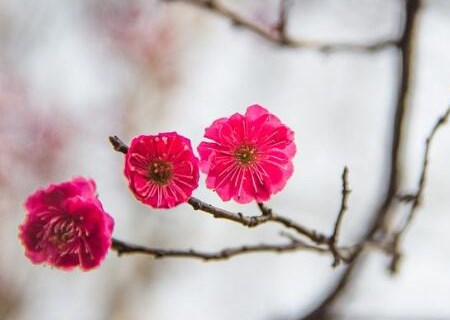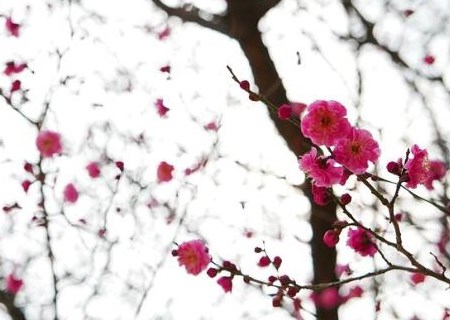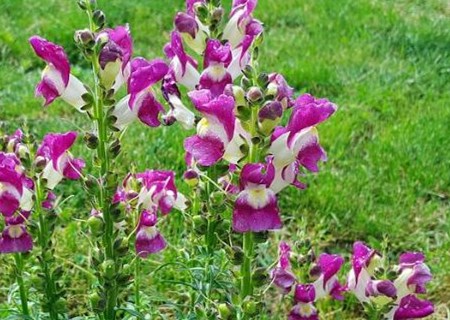How to raise red plum bonsai? How do you trim it? When will it blossom?
Red plum, tall and plump plants are planted alone in an important position or focus of sight, such as near the entrance, in the courtyard or lawn, and can also be cultivated in bonsai. Do you know how to raise red plum bonsai? How do you trim it? When will it blossom? According to a red plum bonsai planting uncle Chen told us that red plums usually blossom in late winter (January-February) or early spring (February-March).

First, how to raise red plum bonsai
1. Place of placement
Red plums like the sun, so be sure to put them in a sunny and well-ventilated place. Red plum should be placed in a sunny and well-ventilated place. Although red plum is more hardy and can blossom in frost and snow, it still likes warmth and is suitable for the climate of the south. If it is cultivated in the cold areas of the north, it should be kept indoors in winter.
2. Selection of basin and use of soil
It is best to choose a mud basin with good permeability and permeability, or you can use a purple sand basin. But don't use porcelain pots and plastic pots. It is better to use loose and permeable soil. 40% of garden soil, 30% of coal cinder and 30% of humus soil can be used together.
3. Watering
Red plum is afraid of stagnant water, so it is necessary to flexibly control the amount of water according to weather changes and growth conditions. Under normal circumstances to keep the basin soil moist as the principle, do not dry do not water. When dry branches and leaves wilt for a long time, you should first pour small water for 2 ~ 3 days to make it gradually restore its vitality. Do not immediately pour heavy water, resulting in a large number of fallen leaves, or even death. In June, when the branches grow to 15-20 cm, the flower buds begin to differentiate. At this time, it is necessary to buckle water, that is, to reduce the amount of water to the plum plant, so that the top tip wilts and then irrigates the top tip for 2 times in a row, so that the top tip will no longer grow and return to normal watering. This method is more difficult to master, the simple way is to hit the top when the branch grows to 15 to 20 centimeters, and if the top grows new buds, then pick it off. Only when the top stops growing, can the flower buds grow well and bloom normally. Water should be poured every time to make the water temperature basically consistent with the temperature of the basin soil.
Usually to keep the basin soil moist, pay attention not to dry do not water, to prevent stagnant water in the basin. From the middle and last ten days of May to the first and middle of June, that is, during the period from flower bud germination to flower bud formation, it is necessary to carry out "buckling water" treatment, that is, let the basin soil dry until the old leaves are slightly curled, and then water again when the new shoots shrink, so as to destroy the growth point of the new shoots several times, so that the new shoots stop elongating, in order to increase the occurrence of flower buds, and then gradually return to normal watering.
4. Fertilization
Red plum likes to be fat, and organic fertilizer should be put into the bottom of the pot after the blossom fade every year. During the growing period, thin fertilizer can be applied every half a month to promote its growth and strength. It is best to apply more phosphate fertilizer before flower bud formation. In addition to applying appropriate amount of base fertilizer when changing pots after pruning in spring, thin and rotten bean cake water or other mature organic fertilizer can be applied after flowering, fertilizing once a month in spring and autumn. In summer and autumn, phosphate and potash fertilizer is mainly applied, which can be irrigated with 2x1000 potassium dihydrogen phosphate solution, or foliar spray, once or twice a month, until flowering. Attention should be paid to the fertilization season, generally, bone meal and bean cake can be placed at the bottom of the basin as base fertilizer, cake fertilizer and water should be applied once or twice before flower bud formation in mid and late May, twice in the first ten days of August, and once more in autumn.
5. Turn the basin
Red plum bonsai is usually turned every 1 to 2 years, and the time should be arranged after flowering. When turning the basin, remove about 1/3 of the old soil, cut off the withered roots, shorten the over-long old roots, and replace them with rotten leaf soil rich in humus, mixed with rice bran ash and sandy soil, so as to make the basin soil fertile, loose and permeable.
6. Pruning and changing pots
Red plum is a new branch in the same year to form flower buds, so every year after flower fade, pruning the old flower branches in time, leaving only 2 to 3 buds, and pay attention to make the buds grow outward, and cut off the cross branches, parallel branches, overlapping branches, opposite branches, long branches, and overdense and thin branches that affect the appearance of the tree. Red plum has strong branching ability and resistance to pruning, so the branches can form flower buds in the same year, so they should be pruned once a year. After flowering or after the flower, when the leaf buds begin to sprout, cut off the dense branches, diseased and weak branches, leaving 2-3 bud holes at the base of each branch, and cut off the rest. At the same time, pour the basin and change the soil, change the basin soil once every 2 ~ 3 years, knock the plum plant out of the basin, remove the original soil, cut off the rotten root, apply appropriate amount of base fertilizer, add the prepared basin soil, plant and compact, pour through water, and move to the place where there is sufficient sunshine for management.
7. Control florescence
After the leaves of red plum fall in winter, move it to a cold room that does not freeze, or put it on a low-temperature balcony, pay attention to window ventilation, so that it after a period of low-temperature stimulation. At the same time, strengthen the management of water and fertilizer, spray water around branches and flowerpots every day to keep the air moist. The temperature began to rise about 1 month before the Spring Festival, initially keeping the room temperature at about 10 degrees Celsius, giving enough sunshine, and raising the room temperature to 1520 degrees Celsius 10 days before the Spring Festival to make it blossom.
8. Pest control
Powdery mildew can occur in summer with high temperature, high humidity and poor ventilation. Bituminous coal disease, etc., can be sprayed with 1500 times liquid of 70% methyl topiramate powder or 1000 times liquid of 50% carbendazim powder. The common insect pests are aphids and spiders, which can be killed with 5000enemy or fenpropathrin (cypermethrin), once a week and twice a week, with good results. Avoid using DDV and dimethoate to avoid drug damage and death.
Second, how to trim red plum
1. Thinning branches
Cut off all kinds of cross branches, parallel branches, overlapping branches, opposite branches, long branches and overdense, thin branches that affect the appearance of the tree. To achieve the principle of "keep the old branches motionless, stay strong and remove the weak".
2. Truncation
That is, on the basis of thinning, the upper part of the one-year-old branch after flowering is cut off. The degree of truncation should be determined according to the modeling needs and growth potential, those with good growth can be cut less, and those with poor growth can be cut more. According to the needs of modeling, sometimes a small number of long branches can be left. When cutting short, we should also choose the direction of the bud mouth according to the direction and angle of the branch, in order to achieve density.
3. Pick the bud
That is, around April, when the leaf buds grow to about 3 cm, according to the location of the buds, density and the needs of the tree shape, pick some unwanted buds. For the buds on the old stem, pick as you go.
4. Pick the heart
That is, when the new shoots grow to a certain length in late June, the terminal buds will be removed to control the growth of branches, and the general length should be 15-30 cm. For the red plum with poor germinating ability, the heart can be picked in advance to promote its re-germination. When the red plum is too old, the tree often becomes weaker. In order to rejuvenate the declining plum trees, the following measures can be taken:
① cut off the lateral branches on the trunk in batches year by year, or cut the lateral branches year by year until they were removed from the base, so as to achieve the purpose of renewal.
When ② renews thick branches, attention should be paid to the protection of wounds to prevent the invasion of diseases and insect pests.
When the plum pot is cultivated in ③, it is best to choose the land with ventilation and light, rich and loose soil, and thinning the branches at the same time. Turn the basin: the red plum bonsai should be turned every 1-2 years, preferably after flowering in March, or from November to December in winter. When turning the basin, remove the old soil 1B3~1B2, cut off the dead roots, shorten the over-long old roots, and replace them with humus-rich rotten leaf soil or frozen loose pond soil, mixed with rice chaff ash and sandy soil.
Red plum pruning pays great attention to seasonality, especially after red plum blossoms in early spring, a lot of nutrition is consumed, so red plum needs to be pruned immediately, do not wait until sprouting and branch before pruning, otherwise it will affect the growth of the year and weaken the tree potential. Sometimes winter shears are carried out to ensure the quantity and quality of red plum blossoms. You can't cut more when you have time and manpower, and don't cut when you don't have time or manpower. In addition, it is best to prune red plum properly before planting new plum trees. Because the root system of newly planted red plum is damaged and the ability of nutrient absorption is weak, if too many branches are left, the supply of nutrition and water can not keep up with, the normal growth of plum trees will be affected, the tree potential will be weakened, and heavy trees may lead to death.
Avoid pruning and ask for faster pruning:
Red plum pruning should be done over and over again, not once and for all. Don't ignore it for a few years after a heavy cut and let it develop. Otherwise, the red plum tree will become a miscellaneous tree with no ornamental value because of its destruction, sparse flowering and even no flowers to enjoy. The growth situation of red plum varies according to the change of climate and environment and the level of daily management every year. Pruning scheme should be determined according to the growth situation of the current year, so as to ensure that each tree has a good shape and blossoms in the next year.
Time: 2019-03-17 Click:
- Prev

What are the planting methods of red plum seeds in Li Yakai? What's the difference between dried plum and preserved plum? How much is one?
Red plum is a kind of plum blossom, this kind of plant can be used in gardens, green spaces, gardens, scenic spots, isolated planting, cluster planting, group planting, etc.; it can also be planted naturally in front of the house, on the slope, between stones and by the roadside. So do you know the planting methods of red plum seeds? What's the difference between dried plum and preserved plum? How much is it per tree?
- Next

What are the seed planting methods of the perennial herbaceous plant Artemisia frutescens? How do you water it? When will it blossom?
Goldfish grass is a perennial herb, named for its flower-like goldfish, gorgeous flowers, very suitable for ornamental, can be potted. So do you know what are the planting methods of goldfish grass seeds? How do you water it? When will it blossom? According to a goldfish farmer, he told us
Related
- Fuxing push coffee new agricultural production and marketing class: lack of small-scale processing plants
- Jujube rice field leisure farm deep ploughing Yilan for five years to create a space for organic food and play
- Nongyu Farm-A trial of organic papaya for brave women with advanced technology
- Four points for attention in the prevention and control of diseases and insect pests of edible fungi
- How to add nutrient solution to Edible Fungi
- Is there any good way to control edible fungus mites?
- Open Inoculation Technology of Edible Fungi
- Is there any clever way to use fertilizer for edible fungus in winter?
- What agents are used to kill the pathogens of edible fungi in the mushroom shed?
- Rapid drying of Edible Fungi

